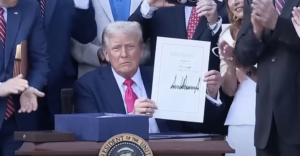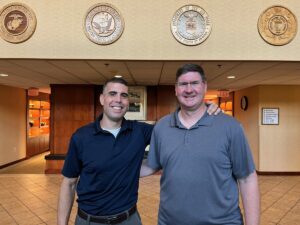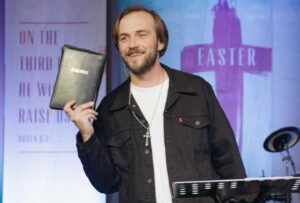
PHOENIX (BP)–How do you touch a booming metropolis of nearly 3 million people with the gospel — and do it in a way that will last? The Phoenix “Valley of the Sun” metropolitan area runs the gamut from extreme poverty to extravagant wealth, with strong contingents of Hispanics, American Indians and an ever-increasing flood of newcomers of every culture.
Organizers of Southern Baptists’ Strategic Focus Cities effort in Phoenix determined that the solution was not in grand region-wide strategies, but in the individual neighborhoods where 170 churches in three different associations were full of people who shared their vision.
“We felt that everything we do here had to be church-based, because we’re not into looking for a short-term event or activity,” said Bill Agee, coordinator for Strategic Focus Cities in Phoenix, which operates under the banner locally of Celebrate Jesus 2000: Caring for the Valley of the Sun. “We’re looking for those things that lead people to long-term involvement.”
Phoenix and Chicago are the first two cities being impacted by Strategic Focus Cities, an evangelism and church-planting initiative of the North American Mission Board and local partners focusing resources and volunteers on two major cities each year.
Phoenix is characterized by its explosive growth, Agee said — with a population expected to double by 2030. It is also a city where neighborhoods and community ties are much stronger than regional identity. Churches in the Valley tend to grow to 600-1000 people — rather than growing into mega-churches — because identity with the neighborhood culture is strong, he said. Growth, he said, typically results in the birth of new churches.
The neighborhood focus also has helped in planning events that effectively reach those particular neighborhoods — whether they be block parties, Vacation Bible Schools or sports clinics.
“What we have to do is find the common denominator of a neighborhood, and who better to do that than the local church,” he said. “If [churches] identify with a particular neighborhood, they know better than anyone else what it will take to reach those people.”
An example of how that works well was at Coronado Baptist Church in Scottsdale, situated about a mile from the Salt River Pima Indian Reservation. The church had been slowly building relationships on the reservation and among its leadership for the past five or six years. So when the opportunity came to host a block party last September, the American Indian community was receptive.
Nearly 3,000 attended, and thus far 167 baptisms have resulted. Another block party and other events are planned for the summer.
“What’s happening now is [the Indians on the reservation] are actually doing the work themselves,” said pastor Mark Hickman. “Our members now are starting to win their neighbors, and invite them and help them to know the Lord.”
He said the Strategic Focus Cities effort has been helpful in highlighting the value of cooperation in doing local ministry.
“Our churches have tended to feel like it’s every man for himself, and [now] they are learning how to use the resources that are available to them,” he said.
Strategic Focus Cities has also helped groups of churches in the city realize a newfound effectiveness in church-to-church partnerships.
“A church might do [a block party] individually, but we’re finding that when three or four churches get together it might have four or five thousand people in attendance,” he said.
Partnerships also have proven the key in drawing outside volunteers as well, Agee said. The Baptist General Convention of Oklahoma has been one of the strongest boosts to the entire Strategic Focus Cities effort with its four-year partnership with the city that began in January. Of about 100 mission trips planned by groups to Phoenix this summer, more than 70 are from Oklahoma.
Agee said the partnership grew out of a recognition that Oklahoma has approximately 1,700 churches reaching the 3 million people in their state, while in Phoenix there are only 170 churches in three associations to reach the same population.
“They’re finding great experiences here, going back and telling their people, ‘Every time I go back there now it’s like a revival time,'” Agee said, with people asking, “Where can we help more and what can we do?”
Local involvement also has been critical to church planting, Agee said. As of early May, 16 churches have been “birthed” with the help of Strategic Focus Cities, and plans are on track for another 33 by the end of the year. And each of those churches, he said, is being started with the backing and resources to produce churches that reproduce themselves within four years. None of the churches started intentionally in this manner over the past 15 years in Phoenix have failed, he said, and he sees no reason why that record cannot continue.
“If we do 49 churches, and they reproduce 45 reproducing churches … we will more than double [the number of churches] in the valley in the next decade,” Agee said.
One of the new starts is an example of how even large-scale church plants are neighborhood oriented. One church being started under a special NAMB program designed to build strong “anchor churches” will be in the massive “live/work/play” community of Anthem, about 15 miles north of Phoenix. The community eventually will be home to 50,000 residents in 20,000 homes.
Mountain Ridge Baptist Church in Phoenix and other local partners are cooperating in the purchase of one of only five pieces of property in the development designated for churches. NAMB also will participate in the funding.
Many of the new church starts will have evangelistic events and volunteers associated with them this summer, while other events are being conducted by existing churches. There are a few large-scale efforts — such as a rodeo Nov. 10-12 being sponsored by 20 area churches and an outreach at the Arizona State Fair in the fall. But most of the 117 evangelistic events during the year are being sponsored by a single church or small group of churches.
One of the strongest efforts will be in Vacation Bible School, which has participation of almost all of the churches in the area and “is going to knock our socks off,” Agee said.
NAMB is providing up to $1,000 per church for promotion and related evangelistic initiatives, and Lifeway Christian Resources has donated almost $50,000 worth of literature. Ritche Carney, a strategic cities planning coordinator for NAMB, said the effort is “one of the strongest examples I know for getting NAMB, Lifeway and the local churches standing shoulder-to-shoulder.”
While many volunteers have been scheduled for the summer’s activities, there are still many opportunities left for churches and individuals who wish to participate in the Phoenix effort.
“We’ve got a few churches that could use some help in Vacation Bible School, particularly if the volunteers are bilingual,” said volunteer coordinator Deborah Wolfrey. “We also have a need in October for help with the State Fair, and for the second week in November with the rodeo.”
One part of Strategic Focus Cities that has helped unify and mobilize local churches has been a commitment of $100,000 to the Jerusalem Fund — which is helping soften the blow to churches and individuals impacted by the collapse of the Baptist Foundation of Arizona last year.
“It gave people a lot of good feelings about the North American Mission Board, the local Strategic Focus Cities process and their Baptist partners in general,” Agee said, noting that the funds were redirected from a planned citywide media campaign.
“What’s more important — putting food on people’s tables or putting an ad on TV? We felt like we would get more benefit for our people and for the Strategic Focus Cities process meeting the needs rather than putting $100,000 in media.”
For more information on becoming involved with Strategic Focus Cities/Celebrate Jesus 2000, visit www.phoenix2000.net on the Internet, or call (602) 957-9160.
–30–
(BP) photos to be posted in the BP Photos section of www.sbc.net.















